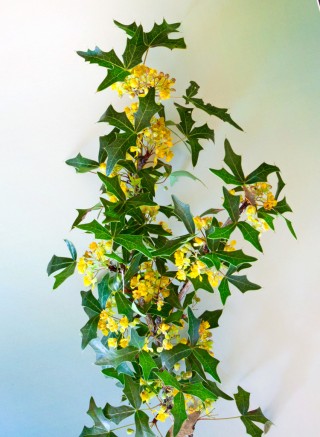
Agarita is a well-armed Brush Country shrub that blooms as early as January in some years. The fragrant yellow flowers are full of nectar and pollen. Agarita is a great honeybee food when little else is available. The tangy red berries are edible and make delicious jellies, pies, and even flavoring for margaritas! Robert Benson Photo.
02/21/2015 – Agarita Margaritas, Anyone?
Today was a beautiful February day in the Brush Country. After two frosty nights, the day dawned clear and cold. By mid-afternoon the sun had warmed the air to a pleasant 60 degrees. It was especially nice because a delicate scent wafted out of the still winter-bare brush.
What was that lovely perfume? I went in search of the source of the smell. Like a bloodhound, nose to the wind, I followed the fragrance. Sure enough, something was blooming in the brush.
The plant was only about three feet high, but up and down its stem were dozens of bright yellow flowers. Each flower measured about a quarter of an inch across. When I pressed my nose up close to the flowers, there it was: that sweet scent. But “Ouch!” there was something more! Each leaf was edged with sharp points!
This prickly denizen of the brush is Agarita. Each leaf on an Agarita shrub consists of three leaflets and each leaflet has three to five spines. These leathery, spiny, dark blue-green leaves look a lot like holly leaves. This feature has led to its other common name: Desert Holly.
But I like the name Agarita which is derived from the Spanish agrito meaning “little sour.” This early-blooming, sweet-smelling, wildlife-protecting plant produces an abundance of tangy red berries in May and June. But the berries are more than a little “sour” straight from the bush! The highly acidic fruit is impossible to enjoy (by us humans) in large quantities without the addition of sugar. Agarita berries, like cranberries and lemons, are so much more palatable when sweetened.
Agarita berries can be made into jellies, pies, wine and even a sweet syrup. In turn, the syrup can be dribbled on vanilla ice cream or be used to flavor cool drinks. A standard lime-flavored, tequila-based margarita can become spectacular with a dash of agarita syrup. Agarita margaritas, anyone?
With these culinary delights in mind, I drove around my brush country backyard today. I have noted the location of over a dozen blooming Agarita shrubs. Each one promises to yield hundreds of the tangy berries. I can hardly wait ‘til May!
However, I wonder how to harvest the berries. The armed shrub is not going to allow easy picking of its fruit. I checked Matt Warnock Turner’s Remarkable Plants of Texas (2009) to get some ideas. The general consensus is to place a sheet (or an upturned umbrella) under the plant. Then you get a broom or a stick and whack the plant, knocking the ripe fruits on to the sheet. Of course, chaff and prickly leaf bits will also be knocked off. To separate the fruits from these bits, one source says to “roll the berries down an inclined board, covered with a wet tow sack.” The theory is that the wet burlap will capture the prickly chaff but the berries will roll right into your bowl. This sounds good to me. Where can I find a tow sack these days?
Although humans have enjoyed Agarita berries for millennia here in South Texas, they are also a good wildlife food. Any animal or bird that can get at the fruits, while avoiding the prickles, has a feast. And some smaller animals hide in the shrub itself, protected from their predators.
Agarita is a valuable honeybee plant. Blooming as early as January in some years, the plant produces “copious amounts of pollen and nectar for the bees at a time when there is precious little to be had.” I noticed today that the blooming plants had already attracted bees.
Watching the bees gather pollen and nectar, I noticed something else. As a bee walked across an Agarita flower, it triggered a response in the stamens. The stamens have touch-sensitive bases so that when a bee touches them, the filament bearing the pollen bends over toward the center of the flower. This makes the pollen sac “bonk” the bee right in the head! The Agarita flower is literally transferring its pollen directly to the body of its pollinator. The pollinating bee, just out for its own benefit, becomes the unwitting purveyor of the plant’s genes to other Agarita flowers. Since few other plants are blooming at this time, the bees are mainly flying from one Agarita to another. Pollination accomplished!
I had to try it for myself. I borrowed a thorn from a blackbrush and peered into a tiny Agarita flower. I wished I had thought to bring a magnifier. Ever so gently, I touched one of the stamens. To my surprise, the stamen on the opposite side of the flower bent in. This behavior might even be an improvement on the-stamen-that-was-originally-touched moving. Think about it. The bee is on a quarter-inch flower. If its forefeet touch the nearest stamen, the pollen sac on the other side of the tiny blossom is perfectly aimed for the insect’s head. Bonk! The bee has a dusting of pollen in the exact place on its body that it will soon insert into another flower.
Isn’t nature amazing?
If you would like to offer comments, please click through to the discussion page
